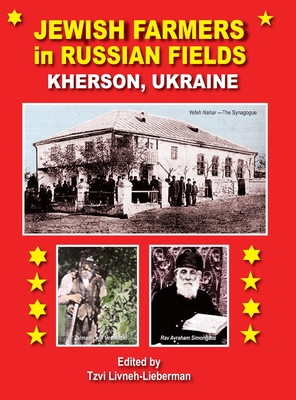Jewish Farmers in Russia Fields

Jewish Farmers in Russia Fields
In the history of Jewish people in the diaspora, the tale of the agricultural settlement of Jews in Southern Ukraine is unique and distinct. The story of this movement, with its colonies, enterprises, struggles, and achievements is being told in this book. There were other attempts at Jewish settlements before the establishment of Israel. They all lasted for limited periods and ceased to exist because their settlers abandoned their settlements. That movement flourished until the day when the torrents of destruction and annihilation descended upon them.
During the beginning of the 19th Czar Alexander I, issued a decree forbidding the Jews from leasing taverns and inns, which meant the expulsion of hundreds of thousands of Jews from the villages in the Pale of Settlement. There was only one positive clause in that decree: The proposal included allocations of land and budgets for that purpose. About 65,000 acre were allocated initially for the Jewish settlers. This was virgin land and was not considered to be very fertile. There was no drinking water there, and the closest cities were 200-400 kilometers away.
Wave after wave, group after group, the Jewish settlers wandered from the northern areas of the Pale of settlements southward to Kherson. Their journey was very long, extremely tough, and full of life dangers. The prairies of Southern Ukraine are seeded with thousands of graves of people who did not make it. The settlers had to endure horrific conditions after arriving until their fields produced enough for them to make a living. Most settlers were pious and Hasidic Jews and the spoken language (including the language taught in the schools) was Yiddish.
The settlement movement has gone through several periods of prosperity and crises, flourishing and decline, waves of incoming settlers, and a period when the independently owned villages were converted to government kolkhozes by the Soviets.
Before WW II, the population of the 500 settlements (by then, they were all kolkhozes) contained about 25,000 Jewish families (or about 150,000 people). They constituted a direct continuation of the 140 years of Jewish settlement.
The Nazis flooded Russian prairies and wiped out the annihilated and demolished an enterprise of five generations of Jewish pioneering farmers.
PRP: 377.89 Lei
Acesta este Prețul Recomandat de Producător. Prețul de vânzare al produsului este afișat mai jos.
302.31Lei
302.31Lei
377.89 LeiIndisponibil
Descrierea produsului
In the history of Jewish people in the diaspora, the tale of the agricultural settlement of Jews in Southern Ukraine is unique and distinct. The story of this movement, with its colonies, enterprises, struggles, and achievements is being told in this book. There were other attempts at Jewish settlements before the establishment of Israel. They all lasted for limited periods and ceased to exist because their settlers abandoned their settlements. That movement flourished until the day when the torrents of destruction and annihilation descended upon them.
During the beginning of the 19th Czar Alexander I, issued a decree forbidding the Jews from leasing taverns and inns, which meant the expulsion of hundreds of thousands of Jews from the villages in the Pale of Settlement. There was only one positive clause in that decree: The proposal included allocations of land and budgets for that purpose. About 65,000 acre were allocated initially for the Jewish settlers. This was virgin land and was not considered to be very fertile. There was no drinking water there, and the closest cities were 200-400 kilometers away.
Wave after wave, group after group, the Jewish settlers wandered from the northern areas of the Pale of settlements southward to Kherson. Their journey was very long, extremely tough, and full of life dangers. The prairies of Southern Ukraine are seeded with thousands of graves of people who did not make it. The settlers had to endure horrific conditions after arriving until their fields produced enough for them to make a living. Most settlers were pious and Hasidic Jews and the spoken language (including the language taught in the schools) was Yiddish.
The settlement movement has gone through several periods of prosperity and crises, flourishing and decline, waves of incoming settlers, and a period when the independently owned villages were converted to government kolkhozes by the Soviets.
Before WW II, the population of the 500 settlements (by then, they were all kolkhozes) contained about 25,000 Jewish families (or about 150,000 people). They constituted a direct continuation of the 140 years of Jewish settlement.
The Nazis flooded Russian prairies and wiped out the annihilated and demolished an enterprise of five generations of Jewish pioneering farmers.
Detaliile produsului









